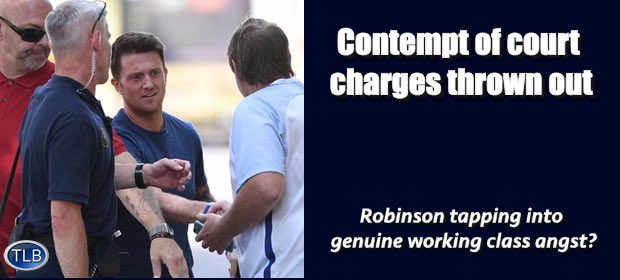
ER Editor: Below, republished by The Spectator, are the reasons for the judgment to throw out the former contempt of court charge against Robinson from May of this year, which earned him jail time. Readers might be interested in today’s Daily Mail piece which has Robinson making a video statement on the ‘mental torture’ he claims to have suffered: ‘I’m not a victim, I’m a target’: Ex-EDL leader Tommy Robinson breaks silence to claim he suffered ‘mental torture’ in prison after winning appeal over 13-month contempt sentence.
 What is interesting is his attack against the establishment mainstream media, which ought to worry them as he does have popular support. Sky News yesterday was clearly obliged, albeit reluctantly so they claimed, to cover his release given the sizable pro-Tommy Robinson demonstration taking place outside the Royal Courts of Justice in London in addition to other news coverage. What was evident from ‘expert’ analysis yesterday on Sky News was a refusal, especially by the representative from academia, that Robinson really does represent working class momentum in the UK, especially against forced mass immigration with no democratic mandate, and I would argue, a general impoverishment of working class British people over a couple of decades. The Robinson case is something to follow with sociological interest.
What is interesting is his attack against the establishment mainstream media, which ought to worry them as he does have popular support. Sky News yesterday was clearly obliged, albeit reluctantly so they claimed, to cover his release given the sizable pro-Tommy Robinson demonstration taking place outside the Royal Courts of Justice in London in addition to other news coverage. What was evident from ‘expert’ analysis yesterday on Sky News was a refusal, especially by the representative from academia, that Robinson really does represent working class momentum in the UK, especially against forced mass immigration with no democratic mandate, and I would argue, a general impoverishment of working class British people over a couple of decades. The Robinson case is something to follow with sociological interest.
**********
Why Tommy Robinson has been released on bail
THE SPECTATOR
Tommy Robinson has been released on bail after he won an appeal against a conviction for contempt of court. Here is the summary of the judgement from today’s hearing at the Court of Appeal. The key passage explaining the decision is in bold (ER has boldfaced other individual statements):
BACKGROUND TO THE APPEALS
The appellant attended Canterbury Crown Court on 8 May 2017 during the trial of four defendants for rape. The jury had been sent out for deliberation. The appellant carried out filming with a commentary on the steps of and inside the court building, although he did not film in the courtroom itself. He had intended to film the defendants but the trial judge had been made aware of his activities and had diverted the defendants through another exit. Notices throughout the court building made it clear that filming or taking photographs at court was an offence and might amount to contempt of court. The appellant had also been told to stop filming by security staff and warned that if he continued he might be committing an offence or be in contempt of court. He was arrested on 10 May 2017 and brought before Canterbury Crown Court. Proceedings were adjourned until 22 May 2017 when the judge explained that his filming could have the effect of substantially derailing the trial. The appellant was represented by leading and junior counsel and apologised to the court. The judge considered that the seriousness of the contempt called for committal and committed the appellant to three months’ imprisonment suspended for 18 months.
The appellant attended Leeds Crown Court on 25 May 2018. He recorded a video of himself standing outside the court building which he livestreamed via Facebook. The duration of the video was approximately 1.5 hours and concerned a trial which was the subject of a postponement order under s.4(2) of the Contempt of Court Act 1981 and its broader circumstances as part of a series of trials. That order prohibited the publication of any report of the proceedings until after the conclusion of that trial and a related trial which was yet to take place. The jury had retired for deliberation. The video was recorded near the entrance used by defendants and jurors. In the video the appellant referred to the trial, the identity of the defendants, the charges against them and to charges which had not been proceeded with against some of the defendants, and he confronted some of the defendants as they arrived at court. The judge was alerted to the appellant’s conduct and he was brought into court where the judge viewed part of the video in the presence of the appellant. The appellant offered to delete the video from Facebook, which the judge required as he was concerned that, if jurors saw it, it might derail the trial and affect the trial yet to start. The judge initiated proceedings for contempt of court against the appellant. Representation was found for the appellant during a 33 minute adjournment. Counsel indicated to the judge that they anticipated submissions of mitigation rather than a defence to the contempt. The particulars of the contempt were not put to the appellant and the appellant was not given the opportunity to admit or deny the contempt. Some mitigation was advanced on behalf of the appellant and the judge proceeded on the basis that the appellant had admitted contempt. The judge committed the appellant to ten months’ imprisonment (reduced from fifteen months for the admission) and activated the suspended committal imposed at Canterbury Crown Court.
JUDGMENT
The judgment of the Court is to dismiss the appeal in respect of the committal for contempt at Canterbury Crown Court and to allow the appeal in respect of the committal for contempt at Leeds Crown Court. The appellant is granted bail and the matter of contempt at Leeds Crown Court is remitted to be heard again. The records are updated to address errors of form at the courts below.
REASONS FOR THE JUDGMENT
Canterbury
The application was brought over a year out of time [5]. The appellant had not previously disputed the finding or sentence imposed at Canterbury Crown Court. The appellant’s complaints were that: (i) he was not served with a written statement containing the particulars required by Crim PR 48.7 [51]; (ii) that the judge failed to make plain whether she was exercising powers under s.41 of the Criminal Justice Act 1925 or her inherent jurisdiction in respect of criminal contempt [56]; and (iii) the judge had, in passing the suspended committal order, used terminology of criminal sentencing rather than committal for contempt [57].
As to (i), the appellant had been served with four witness statements, two of which were made by security staff and two by members of the public, relating to the appellant’s activities on the day of the alleged complaint [51]. No complaint was made at the adjourned hearing as to lack of clarity about the nature of the allegations which the appellant faced; late disclosure after the appeal hearing revealed that counsel had taken a tactical decision not to ask the judge spell out in full the specific actions constituting contempt [52-54]. Accordingly, there had been no real prejudice to the appellant in the failure to particularise the contempt [55]. Whilst the judge had made reference to s.41 CJA 1925 in her remarks, the matter did not proceed in the Crown Court as a summary prosecution for a breach of s.41. Instead, the judge had expressly stated that she found clear evidence of contempt. The fact that she supplemented her finding of criminal contempt with observations that the facts could also give rise to an offence under s.41 CJA 1925 does not invalidate her conclusions on criminal contempt [56]. Lastly, the judge had indeed used terminology of criminal sentencing and wrongly purported to pass a “sentence”. However, it was conceded that a court has power to suspend a committal to prison for contempt. This is undoubtedly what the court was seeking to achieve and it was what was understood by those representing the appellant at the time. It was also plain from the content of the broadcast outside Leeds Crown Court that the appellant understood that a second finding of contempt of court within 18 months of the Canterbury offence would risk implementing the suspended period of imprisonment [57].
There was no merit in the underlying proposed appeal. Time would not be extended. The court directs that the record be updated to use the language of committal and not criminal sentencing [59].
Leeds
The application was brought 20 days out of time [5]. The appellant’s complaints were that: (i) the judge should not have proceeded as quickly as he did, initiating and completing proceedings that day [60]; (ii) no particulars of contempt were put to the appellant [64]; and (iii) insufficient mitigation was put forward as a result of the haste [68].
The court agrees that the judge should not have commenced the hearing of contempt proceedings that day. Once the appellant had removed the video from Facebook, there was no longer sufficient urgency to justify immediate proceedings [62]. In those circumstances it would have been preferable to adjourn, as had happened in the Canterbury proceedings. No particulars of the contempt were formulated or put to the appellant. There was a muddle over the nature of the contempt being considered. In both the short explanation given by the judge of the general nature of the alleged contempt and the sentencing remarks, there was reference to matters that could not be a breach of the section 4(2) order. [64]. The failure to follow Part 48 Crim PR was more than technical [66]. There was no clarity about what the appellant was admitting or on what basis he was being sentenced. Finally, further difficulties arose from the limited opportunity that counsel had to investigate mitigation [68]. There was little else which counsel could have done within the constraints under which he was working. The level of detail which could be provided to the court was very limited and there was no opportunity to obtain character references [69]. A sense of proportion must be retained. Where a custodial term of considerable length is being imposed, it should not usually occur so quickly after the conduct which is complained of [69]; a sentence of committal to immediate custody had been pronounced within five hours of the conduct taking place [8].
The order at Leeds Crown Court was also erroneously drawn up to suggest the appellant had been convicted of a criminal offence rather than having been committed for contempt of court [70]. Errors like this have serious consequences upon the classification of prisoners, resulting in the deprivation of privileges [74] and release on licence [75]. In this case, it also resulted in the erroneous imposition of a victim surcharge [76].
The finding of contempt in Leeds is quashed [77]. All consequential orders fall away. The court remits the matter of alleged contempt at Leeds Crown Court to be heard again before a different judge [78]. The appellant is granted conditional bail pending the rehearing [86].
General guidance is given on contempt of court procedure [79-82].
References in square brackets are to paragraphs in the judgment.
This summary was originally published on the judiciary website here.
Original article
ER recommends other articles by The Spectator




